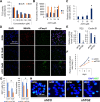Targeting transglutaminase 2 mediated exostosin glycosyltransferase 1 signaling in liver cancer stem cells with acyclic retinoid
- PMID: 37308486
- PMCID: PMC10261105
- DOI: 10.1038/s41419-023-05847-4
Targeting transglutaminase 2 mediated exostosin glycosyltransferase 1 signaling in liver cancer stem cells with acyclic retinoid
Abstract
Transglutaminase 2 (TG2) is a multifunctional protein that promotes or suppresses tumorigenesis, depending on intracellular location and conformational structure. Acyclic retinoid (ACR) is an orally administered vitamin A derivative that prevents hepatocellular carcinoma (HCC) recurrence by targeting liver cancer stem cells (CSCs). In this study, we examined the subcellular location-dependent effects of ACR on TG2 activity at a structural level and characterized the functional role of TG2 and its downstream molecular mechanism in the selective depletion of liver CSCs. A binding assay with high-performance magnetic nanobeads and structural dynamic analysis with native gel electrophoresis and size-exclusion chromatography-coupled multi-angle light scattering or small-angle X-ray scattering showed that ACR binds directly to TG2, induces oligomer formation of TG2, and inhibits the transamidase activity of cytoplasmic TG2 in HCC cells. The loss-of-function of TG2 suppressed the expression of stemness-related genes, spheroid proliferation and selectively induced cell death in an EpCAM+ liver CSC subpopulation in HCC cells. Proteome analysis revealed that TG2 inhibition suppressed the gene and protein expression of exostosin glycosyltransferase 1 (EXT1) and heparan sulfate biosynthesis in HCC cells. In contrast, high levels of ACR increased intracellular Ca2+ concentrations along with an increase in apoptotic cells, which probably contributed to the enhanced transamidase activity of nuclear TG2. This study demonstrates that ACR could act as a novel TG2 inhibitor; TG2-mediated EXT1 signaling is a promising therapeutic target in the prevention of HCC by disrupting liver CSCs.
© 2023. The Author(s).
Conflict of interest statement
The authors declare no competing interests.
Figures







Similar articles
-
Molecular mechanism by which acyclic retinoid induces nuclear localization of transglutaminase 2 in human hepatocellular carcinoma cells.Cell Death Dis. 2015 Dec 3;6(12):e2002. doi: 10.1038/cddis.2015.339. Cell Death Dis. 2015. PMID: 26633708 Free PMC article.
-
Prevention of hepatocellular carcinoma by targeting MYCN-positive liver cancer stem cells with acyclic retinoid.Proc Natl Acad Sci U S A. 2018 May 8;115(19):4969-4974. doi: 10.1073/pnas.1802279115. Epub 2018 Apr 23. Proc Natl Acad Sci U S A. 2018. PMID: 29686061 Free PMC article.
-
Regulation of transglutaminase-mediated hepatic cell death in alcoholic steatohepatitis and non-alcoholic steatohepatitis.J Gastroenterol Hepatol. 2012 Mar;27 Suppl 2:52-7. doi: 10.1111/j.1440-1746.2011.07009.x. J Gastroenterol Hepatol. 2012. PMID: 22320917
-
The Outside-In Journey of Tissue Transglutaminase in Cancer.Cells. 2022 May 29;11(11):1779. doi: 10.3390/cells11111779. Cells. 2022. PMID: 35681474 Free PMC article. Review.
-
Pharmaceutical and nutraceutical approaches for preventing liver carcinogenesis: chemoprevention of hepatocellular carcinoma using acyclic retinoid and branched-chain amino acids.Mol Nutr Food Res. 2014 Jan;58(1):124-35. doi: 10.1002/mnfr.201300538. Epub 2013 Nov 24. Mol Nutr Food Res. 2014. PMID: 24273224 Review.
Cited by
-
Hepatocellular carcinoma stem cells: the current state of small molecule-based inhibitors.Cell Death Dis. 2025 Sep 1;16(1):666. doi: 10.1038/s41419-025-07983-5. Cell Death Dis. 2025. PMID: 40890130 Free PMC article. Review.
-
Cell death-related signature genes: risk-predictive biomarkers and potential therapeutic targets in severe sepsis.Front Med (Lausanne). 2025 May 30;12:1577203. doi: 10.3389/fmed.2025.1577203. eCollection 2025. Front Med (Lausanne). 2025. PMID: 40520803 Free PMC article.
-
Transglutaminase 2 Stimulates Cell Proliferation and Modulates Transforming Growth Factor-Beta Signaling Pathway Independently of Epithelial-Mesenchymal Transition in Hepatocellular Carcinoma Cells.Int J Mol Sci. 2025 Jun 8;26(12):5497. doi: 10.3390/ijms26125497. Int J Mol Sci. 2025. PMID: 40564959 Free PMC article.
References
Publication types
MeSH terms
Substances
LinkOut - more resources
Full Text Sources
Medical
Miscellaneous

